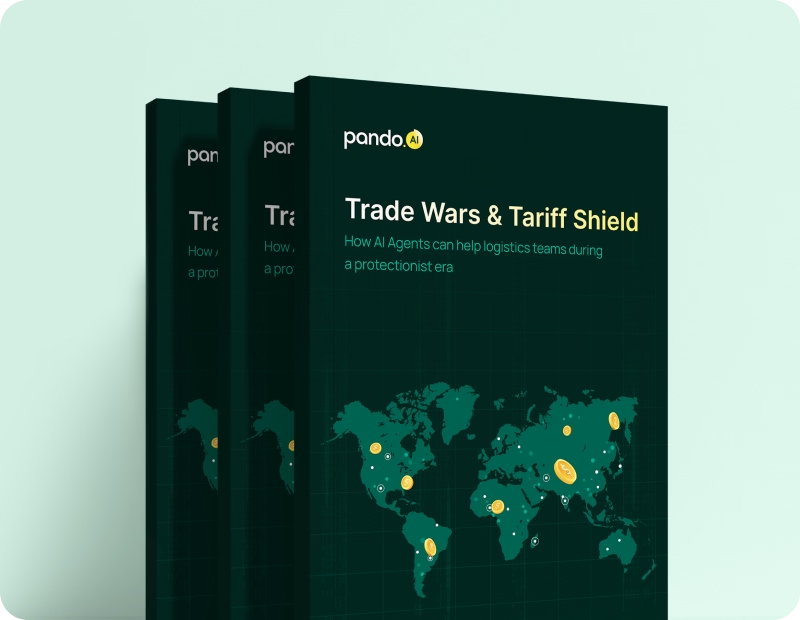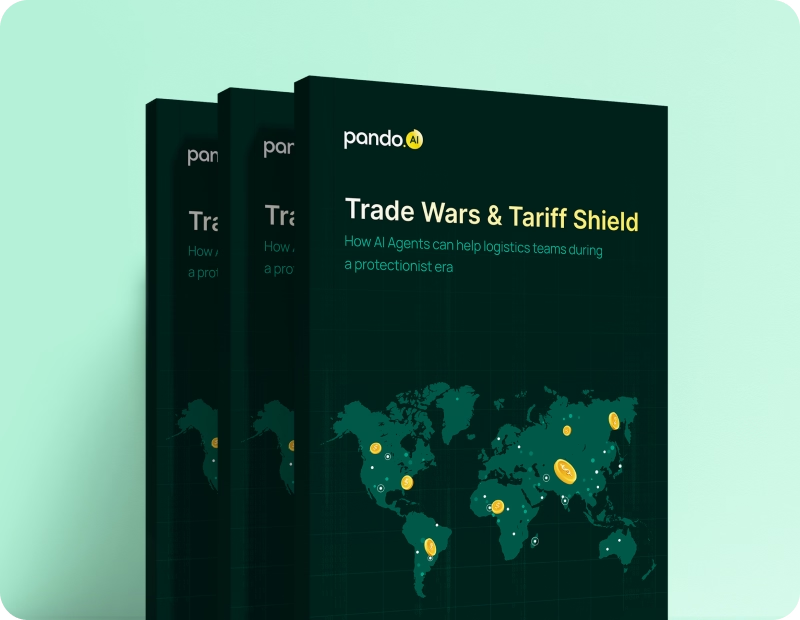-
Products Products
- Industry
- Initiatives
- Resources
- Company
- Book a demo

Before you go: Logistics leaders just dropped the truth on AI
The State of AI in Logistics 2025 is here — no hype, just real conversations and raw insights.
Rethinking freight bidding: Achieve efficiency and agility with AI agents
Transform your procurement process with intelligent, scenario-driven bidding solutions for smarter decisions and better outcomes.
Published on January 2, 2025 • 7 mins read
Durga Pratiha

Transform your procurement process with intelligent, scenario-driven bidding solutions for smarter decisions and better outcomes.
At its core, freight bidding is more than just selecting the lowest-cost carrier. It’s a strategic process driven by the need to navigate volatile freight rates, razor-thin margins, and the complexities of aligning logistics operations with broader business goals. Success in this process ensures cost-efficiency, reliability, and scalability, factors critical to staying competitive in today’s dynamic market.
But are you sure your tools are truly advancing your agenda, or are they inadvertently creating roadblocks? Many shippers face common challenges such as fragmented bid submissions, incomplete data, and time-intensive evaluations. Layer on external pressures like fluctuating fuel prices, labor shortages, and geopolitical instability, and inefficiencies become almost unavoidable.
The root cause? The process design itself. While many systems offer automated workflows and streamlined interfaces, they often fall short when dealing with real-world complexities. Handling multi-round bidding, accommodating custom cost scenarios, or adapting to sudden demand shifts is where these tools struggle—leaving shippers unable to manage the nuances of modern freight bidding effectively.
The consequence is reactive decision-making. Instead of proactively shaping strategies, shippers are forced into last-minute choices that inflate costs, reduce service reliability, and ultimately erode operational efficiency.
This blog reimagines freight procurement by placing AI agents at the center. Learn how advanced automation and predictive scenario modeling can revolutionize your approach—empowering you to make smarter decisions, mitigate risks, and drive efficiency across your operations.
Challenges in freight bidding: Why the process needs a rethink
Freight bidding is supposed to be a straightforward process to match your logistics needs with the right carriers, but let’s be honest—it rarely is. From juggling inconsistent formats to dealing with incomplete data and clunky systems, the process often feels more like firefighting than strategic planning. Here’s what’s really holding shippers back.
-
Non-standardized bid formats
Consider the scenario where you have sent your bid request to 20 carriers. One sends an organized spreadsheet. Another sends a PDF. A few provide lane-specific details but in completely different formats. Now you’re stuck trying to merge this chaos into something you can analyze.
Here’s the problem: most tools you rely on are great at automating the basics but fail miserably when faced with this lack of uniformity. They aren’t equipped to clean, standardize, or process this patchwork of data, leaving you elbow-deep in manual adjustments.
What happens next? You waste days, sometimes weeks, just making sense of the submissions. By the time you’ve figured it out, the best carriers may have moved on to other opportunities, leaving you with limited options and higher costs.
-
Missing or incomplete data
You’ve secured a carrier with a seemingly competitive rate, only to discover midway through the contract that accessorial fees or guaranteed service timelines were conveniently left out of their bid. Suddenly, you're left grappling with unexpected costs and delays.
Data validation processes often fall short, they might catch glaring mistakes but fail to identify critical omissions like nuanced service terms or hidden charges. These oversights leave you operating with incomplete information, undermining the foundation of your decisions.
The consequences? What initially appeared to be a cost-saving move spirals into operational headaches. Delayed deliveries, budget overruns, and strained carrier partnerships become routine issues, chipping away at efficiency and trust in your procurement strategy.
-
Manual bid analysis
Let’s say you’re managing bids for hundreds of lanes. The data is all over the place: rates, service levels, carrier performance metrics and you’re tasked with manually piecing it all together. It’s not just tedious; it’s a huge drain on time and energy.
Spreadsheets and outdated systems might help you compile the data, but they don’t simplify the analysis. Cross-referencing service terms with past performance? That’s nearly impossible. These systems lack the sophistication to tackle the complexities of modern freight procurement.
When decisions are rushed or based on incomplete insights, they result in carrier selections that look good on paper but don't perform well when it's most important.
-
Limited scenario modeling
You’re considering whether to stick with your current carriers or bring in new ones. Maybe you want to test how adding a regional carrier affects costs or capacity. But the tools you’re using don’t allow for that kind of flexibility. They force you into rigid templates with no room to explore what-ifs.
Without advanced modeling capabilities, you’re left making decisions based on guesswork. How will your choice impact cost, capacity, or service levels? You won’t know until it’s too late.
This rigidity limits your ability to make strategic, data-driven decisions, leaving you reactive instead of proactive. It’s a missed opportunity to optimize your logistics in a way that truly aligns with your broader business goals.
-
Navigating market volatility
Fuel prices spike, a major carrier faces capacity shortages, or geopolitical events throw your supply chain into disarray. Sound familiar? Freight markets are anything but stable, yet the tools you rely on operate as if they are.
Most systems use static inputs and predefined workflows, offering little to no flexibility to adjust in real-time. When market conditions shift, you’re left scrambling to adapt manually.
This results in higher costs, frustrated stakeholders, and loss of competitive advantage. Instead of staying ahead of disruptions, you’re constantly playing catch-up.
-
Collaboration and transparency gaps
You’ve drafted a bid request, but some details are vague. Carriers respond based on their interpretation, and now you’re in a back-and-forth trying to clarify requirements. Weeks pass, and the process grinds to a halt.
Ambiguity and lack of transparency create inefficiencies from the start. And because traditional workflows don’t prioritize seamless collaboration, shippers and carriers are left guessing.
Further negotiations are hampered by delays in decisions, missed opportunities for competitive pricing, and strained relationships.
How AI agents transform the freight bidding process
The complexities of freight bidding demand more than traditional systems can offer. AI agents step in as intelligent collaborators, analyzing data, adapting to market changes, and simulating scenarios in real-time. Unlike current tools, they bring precision, agility, and scalability to every stage of the process, helping shippers tackle challenges like dynamic pricing, multi-round bids, and capacity constraints.
Let’s explore how AI agents reshape freight bidding to drive smarter, more efficient outcomes.
1. Bid summarization for clarity and accuracy
Carrier bids are packed with layers of details: base rates, fuel surcharges, and accessorial fees, often buried within overwhelming data. This sheer volume makes manual analysis ineffective, leading to missed nuances and critical gaps. AI agents tackle this challenge head-on by automatically parsing and summarizing bid data, highlighting inconsistencies, and flagging missing details. For instance, hidden costs like detention fees or layover charges are identified and incorporated into bid evaluations, leaving no room for surprises.
This approach not only ensures cost accuracy but also accelerates evaluations, reduces errors, and frees up time for more strategic decision-making.
2. Advanced scenario modeling for smarter strategies
AI agents enable you to simulate multiple procurement strategies, empowering you to explore “what-if” scenarios with granular detail. Whether it’s trade-offs between shorter lead times and lower costs or optimizing allocations for peak season capacity, AI models provide actionable insights tailored to your priorities.
- Dynamic data integration: Real-time data integration, such as fuel price changes, carrier capacity fluctuations, or port congestion, is continuously integrated by AI, ensuring your models remain relevant throughout the bid process.
- Multi-scenario simulations: AI generates a range of scenarios to compare cost, reliability, and capacity outcomes. For instance, you can model:
- Allocating higher volumes to incumbents for service consistency.
- Evaluating trade-offs between spot market reliance and contract pricing.
- Adjusting carriers mix to manage disruptions or optimize for sustainability goals.
This dynamic modeling ensures you can pivot strategies mid-bid to account for unforeseen disruptions without delays, enabling faster, better-informed decisions.
3. Multi-round bid management without the hassle
Freight bidding rarely concludes in a single round; it’s a multi-stage process where rates, terms, and commitments shift dynamically. Each adjustment, whether it’s revised lane commitments, new spot rate updates, or volume reallocation adds layers of complexity that can quickly overwhelm traditional approaches. AI agents simplify this intricate process by acting as a centralized intelligence hub, automatically tracking, integrating, and analyzing every change across rounds.
With AI, shippers can eliminate manual tracking and reduce errors stemming from misaligned data between rounds. These agents also provide visibility into trends and patterns, helping you anticipate and address discrepancies before they escalate. For example, AI can identify inconsistencies in lane commitments after multiple rounds and flag potential risks, ensuring alignment between carrier promises and operational needs.
This capability not only enhances accuracy but also speeds up decision-making, enabling you to respond to counteroffers faster and secure better outcomes. By maintaining a cohesive, real-time view of evolving negotiations, AI agents ensure you stay proactive, reduce friction, and achieve optimal agreements that balance cost, service, and reliability.
4. Real-time adaptability during bidding events
Market disruptions, such as capacity shortages or fuel price hikes, can significantly impact the progress of ongoing bidding events. AI agents excel in adapting to these mid-process challenges, powered by scenario modeling that recalibrates strategies in real time.
For example:
- Carrier withdrawals: If a preferred carrier pulls out, AI instantly adjusts allocations across remaining carriers to secure capacity without compromising timelines.
- Sudden cost spikes: AI can simulate trade-offs to evaluate short-term higher costs against long-term service reliability, helping shippers make quick, data-backed decisions.
By combining real-time adaptability with advanced scenario modeling, AI agents ensure procurement strategies remain agile, targeted, and resilient to market volatility—capabilities that current tech stacks simply cannot match.
Optimize bid outcomes with agentic AI
Freight bidding has evolved from a routine task to a powerful driver of efficiency, cost control, and strategic advantage. Yet, current tech stacks often fall short, bogged down by rigid frameworks, incomplete data handling, and limited adaptability. These limitations leave shippers navigating inefficiencies and missing critical opportunities for optimization.
Agentic AI redefines what’s possible in freight procurement. By automating templates, modeling intelligent scenarios, and optimizing bids in real-time, AI agents tackle complexities that current systems can’t. They adapt fluidly to market dynamics, ensuring precision, agility, and actionable insights at every stage of the bidding process. The result? Faster, smarter decisions that don’t just meet today’s challenges but position your supply chain for future success.
One of Pando’s clients struggled with inefficiencies in their bidding process. They faced poor decision-making, but the real challenge was knowing where to start. Our agentic AI changed the game. By integrating predictive and generative intelligence, Pando streamlined their multi-round bids, adjusted dynamically to market volatility, and ensured every detail—down to accessorial fees—was accounted for.
This isn’t just theory. Our AI solutions eliminate inefficiencies by enabling faster evaluations and reducing manual reconciliation, helping Pando’s clients achieve measurable cost savings and improve carrier reliability.
Instead of navigating complexities with outdated tools, Pando’s clients now make smarter, faster decisions that drive real impact. Let us help you turn freight procurement challenges into opportunities for growth and efficiency.
Subscribe to Pando blog and Crossroads newsletter now!
Stay up to date with the latest logistics, transportation, and supply chain tips and news.
Subscribe Here!












